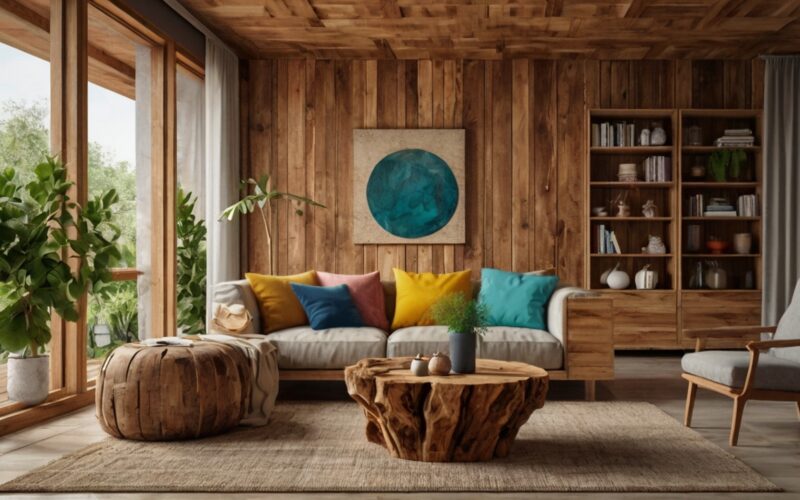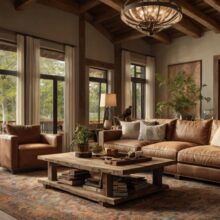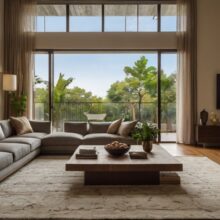How to Decorate Your Home Sustainably – A Guide to Eco-Friendly Living

How to Decorate Your Home Sustainably – A Guide to Eco-Friendly Living
Picture this: you step into your living room, sunlight streaming through a hemp curtain, a reclaimed wood coffee table catching your eye, and a lush indoor plant breathing life into the space. This isn’t just a pretty scene—it’s a sustainable one. Decorating your home sustainably is about more than chasing trends; it’s a chance to craft a space that reflects your style while honoring the planet. With terms like “carbon footprint” and “green living” buzzing around, you might wonder: Can my decor choices really make a difference? Spoiler alert: they can. In this guide, we’ll unpack how to decorate your home sustainably, diving into the why, the how, and the real-world wins that make eco-friendly interior design a game-changer.
Why Sustainable Decor Matters
Let’s start with the big picture. Every sofa, rug, or wall hanging you bring home has a backstory—of resources mined, energy burned, and waste left behind. Traditional decor often leans on cheap, mass-produced goods that chew through forests, pollute waterways, and end up in landfills within a few years. Sustainable home decor flips that script. It’s about choosing materials that renew, production that respects workers, and designs that last—not just physically, but in your heart.
But it’s not all about saving the planet (though that’s a huge perk). There’s a personal upside, too. Ever notice how a room with natural wood or a cascade of greenery feels calmer? Science backs this up—biophilic design, which weaves nature into interiors, can lower stress and sharpen focus. Then there’s the pride factor: knowing your thrifted armchair or organic cotton throw supports green living feels good. Whether you’re a minimalist paring down to essentials or a maximalist layering vintage finds, sustainable decor bends to your vision while keeping the Earth in mind.
Practical Tips for Eco-Friendly Decorating
Ready to roll up your sleeves? Sustainable decorating doesn’t mean a total overhaul—it’s about smart swaps and creative twists. Here’s how to weave eco-friendly interior design into your home:
1. Hunt for Second-Hand Gems: Why buy new when preloved pieces have soul? Hit up thrift stores, estate sales, or platforms like Craigslist for furniture with history. A scuffed oak dresser can become a showstopper with a coat of non-toxic paint.
Bonus: reusing cuts demand for new production, slashing energy use.
2. Pick Planet-Friendly Materials: Swap particleboard for reclaimed wood or bamboo—fast-growing and renewable. For textiles, think organic cotton, linen, or hemp over polyester, which sheds microplastics.
Pro tip: check labels for certifications like GOTS (Global Organic Textile Standard) to ensure authenticity.
3. Upcycle with Flair: Got old jars or crates lying around? Turn them into quirky planters or wall shelves. A quick YouTube search for “upcycled furniture ideas” can spark projects like a pallet headboard or wine cork art. It’s low-waste and high-fun.
4. Shop Local and Ethical: Skip the big-box hauls and support nearby makers. A hand-thrown ceramic vase or a woven rug from a local artisan cuts shipping emissions and boosts your community. Look for fair-trade labels to ensure workers thrive, too.
5. Go Low-VOC: Paint and finishes matter. Volatile organic compounds (VOCs) in standard paints pollute indoor air—opt for low- or zero-VOC options instead. Brands like Benjamin Moore Natura or ECOS Paints deliver color without the toxins.
These ideas blend practicality with purpose. The goal? A home that’s uniquely yours—without costing the Earth.
Real-World Examples of Sustainable Design
Need proof this works? Let’s peek at some folks living the sustainable decorating ideas dream. Meet Jamie, a DIY enthusiast from Austin, Texas. She transformed her cramped apartment with a thrifted mid-century sofa she reupholstered in organic linen, paired with a coffee table made from salvaged barn wood. “It’s not just about looks,” she says. “Knowing it didn’t harm the planet makes it special.” Her space now hums with warmth—and a story.
Then there’s designer Jasper Morrison, a minimalist icon who champions sustainability. In a London project, he used cork flooring—renewable and cozy underfoot—alongside vintage steel chairs sourced from a defunct factory. His ethos? “Good design should last forever.” It’s a reminder that eco-friendly interior design can be sleek and timeless.
For a bolder take, look at the Hendersons in Vancouver. They installed a living wall of ferns and moss in their den, inspired by biophilic trends. Paired with reclaimed brick accents and a jute rug, it’s a sanctuary that purifies air and wows guests. These stories show sustainability isn’t a monolith—it’s a playground for creativity, from rustic to avant-garde.
Overcoming Challenges in Sustainable Decor
Let’s get real: sustainable decorating has its hiccups. First up, cost. A reclaimed oak table might run $500, while a big-box knockoff costs $100. Accessibility’s another snag—not everyone has a thrift store around the corner or artisans in reach. And time? Refinishing a chair or sewing curtains beats the instant gratification of same-day delivery.
So, how do you push past these? Scale matters—start with one piece, like a second-hand lamp, and build from there. Budget tight? Hunt sales or barter skills (say, baking for a friend’s old mirror). If local options are slim, scour online marketplaces—Etsy’s vintage section or eBay can deliver upcycled furniture to your door. Time-crunched? Focus on quality buys that endure; a solid wood shelf outlasts flimsy MDF tenfold.
Aesthetics can trip folks up, too. Does sustainable mean sacrificing polish? Not at all. Pair a rugged reclaimed table with sleek glassware, or drape a bold linen throw over a minimalist sofa. The tension between eco-goals and style is where magic happens—think of it as a design puzzle to solve. And the payoff? Beyond a lighter footprint, sustainable choices can hike home value (buyers love eco-upgrades) and spark joy that cheap decor never will.
Conclusion: Your Sustainable Decor Journey Starts Now
Decorating your home sustainably isn’t a checkbox—it’s a mindset. It’s picking that weathered sideboard because it’s got a past, planting a fiddle-leaf fig to breathe life into your corner, or painting with hues that don’t poison the air. Every choice ripples outward, trimming waste, supporting makers, and crafting a space that’s truly yours. The beauty of sustainable home decor is its adaptability—whether you lean sparse or eclectic, there’s a green path for you.
So, what’s your first step? Maybe it’s a Saturday thrift crawl with a friend, a quick DIY using scraps, or a peek at local crafts fairs. Don’t overthink it—start where you stand. Your home’s waiting to tell a story that’s as good for the planet as it is for your family. Hungry for more? Dig into blogs on green living, hunt down eco artisans near you, or sketch out your next project. The sustainable life isn’t just a trend—it’s a revolution.



